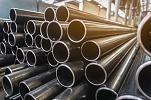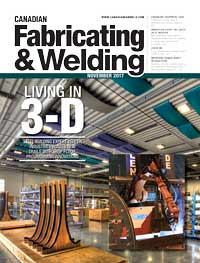Editor
- FMA
- The Fabricator
- FABTECH
- Canadian Metalworking
21st century trades on show
Red River College’s new Skilled Trades and Technology Centre aims to put a new face on the campus, attract students to its classrooms
- By Rob Colman
- December 13, 2017
- Article
- Fabricating

An artist's rendering of the concourse in the new Skilled Trades and Technology Centre (STTC). Images courtesy of Red River College.
The 1960s were a great time for educational institutions in Canada. New colleges and universities were introduced across the country, creating broader opportunities for study among the growing population.
The buildings used to house those institutions, however, also were a product of their time. Most were monolithic concrete structures, letting in little natural light, and presenting an austere face to the outside world.
Red River College’s main campus in Winnipeg is like dozens of others in this respect. It has nurtured generations of students and faculty, but its physical presence hasn’t advertised its strengths to the community at large. It has been working hard to change that and has five major capital improvement projects in flight. The fifth is the largest addition to the college’s main campus on Notre Dame Avenue in Winnipeg since the college built the Heavy Equipment Transportation Centre in 2008.
The project is the new Skilled Trades and Technology Centre (STTC), which advertises to the students and the broader community the advanced processes and technologies being developed and worked on by staff and students in some of the trades programs. It aims to promote the skilled trades by putting them front and centre, making students aware of the opportunities the college offers to the right applicant.
A King’s Entrance
The STTC is a new, 110,000-sq.-ft. facility currently under construction that extends from the eastern edge of the original central campus building out to King Edward Street, the busy north-south thoroughfare that skirts the college grounds. Having this new building reach out to King Edward will change the way in which many students enter the campus.
“Currently all buses turn onto Notre Dame (the southern border of the campus) and make a loop in front of the main entrance to the college,” said Patrick Kuzyk, chief capital projects officer at Red River. “Not only will having an entrance on King Edward relieve that congestion, it will increase our presence on that main route and invite students to walk the length of a facility that will feature a broad expanse of trades and state-of-the-art technologies.”
The skilled trades that will be taught in the building include sheet metal fabrication, CNC machining, robotics, refrigeration, electrical, and carpentry. The construction and fabricating trades will be housed in two-storey open spaces that will benefit from natural light streaming in through skylights and solar tubes that run the length of the building. Next to these rooms will be two 32-seat CAD labs on the second floor, a materials lab, and offices. Below those will be the refrigeration class facilities and the CNC machining labs. The CNC machining lab is being outfitted by Haas to include a new 5-axis machining centre, as well as a new lathe and mill. These are additions to a machining lab that already includes another 26 machines. The machining centre is being set up to be visible and inspiring to students, faculty, and visitors as they pass by. The robotics centre is being designed with similar visibility in mind.
“We have had a robotics lab for some time, but this will finally give it some visibility,” said Bill Noakes, chair of mechanical, manufacturing, and communications at Red River. With new investments in the college, there will soon be more robotics applications available to see in that new space.
Cross-pollination on Display
Noakes and many of the other staff members affected by the changes the new facility will bring have been heavily involved in the planning process.
“The great part of the facility as a whole is that it demonstrates that as trades we’re not separate,” said Noakes. “You can see how all of these jobs work together, which is what you’d see in industry. In some ways, we try to mimic what students would actually experience on a shop floor.”
The cross-pollination of disciplines happens in different ways for different parts of the new facility. For instance, the sheet metal, carpentry, and electrical disciplines are all tied together in the college’s building trades area. Meantime, CNC machining and robotics are tied to transportation, aviation, and manufacturing programs that include access to 3-D printing facilities and composite manufacturing that will be adjacent to the CNC machining lab.
New Sheet Metal Additions
The sheet metal shop is a big winner in this move to a new facility. It will feature two new press brakes, a new shear supplied by Empire Machinery, and a CO2 laser that is being leased so that the college can update this technology as necessary.
“The building is being structurally modified to give us paths through which we can put large equipment in and take it out as necessary,” said Kuzyk. “We learned from visiting facilities like Calgary’s SAIT that flexibility is key for any trades school. We want to be able to move equipment in and out as trades change and needs change.”
Kuzyk was particularly impressed by the process that each department went through to ensure that the setup of the machines in the facility would be optimal once it’s all up and running.
“The machinery was selected and then laid out in plans that went back and forth,” he noted. “Although it all looked like it fit, once the shell of the building was prepared, they went onto the floor and sprayed the layout onto the ground to ensure that it would function as necessary. In the case of the sheet metal shop, we found that in one case there was not sufficient allowance given for the sheet metal that would extend beyond a machine while it was being operated. That process was really valuable to help us understand how the space could best be used.”
Growing With Demand
The new building will accommodate around 350 students at any given time, and Kuzyk said it will likely welcome 1,000 students a day, plus staff.
“Enrollment for some of our new programs is going through the roof,” he said. “And this space is going to be high-tech and will show students how technology is changing. The building is a living lab displaying the performance of windows, walls, roof, and operating systems in a real time to the students on monitors located throughout the facility.”
The college’s welding program may be the next beneficiary of this drive for change. It is right around the corner from the new facility and will likely benefit somewhat from the robotics lab.
The STTC is on schedule to be complete and open by late 2018.
Editor Robert Colman can be reached at rcolman@canadianfabweld.com.
Red River College, 204-632-3960, www.rrc.ca
About the Author

Rob Colman
1154 Warden Avenue
Toronto, M1R 0A1 Canada
905-235-0471
Robert Colman has worked as a writer and editor for more than 25 years, covering the needs of a variety of trades. He has been dedicated to the metalworking industry for the past 13 years, serving as editor for Metalworking Production & Purchasing (MP&P) and, since January 2016, the editor of Canadian Fabricating & Welding. He graduated with a B.A. degree from McGill University and a Master’s degree from UBC.
subscribe now


Keep up to date with the latest news, events, and technology for all things metal from our pair of monthly magazines written specifically for Canadian manufacturers!
Start Your Free Subscription- Trending Articles
BlueForge Alliance partners with Nuts, Bolts & Thingamajigs to develop Submarine Manufacturing Camps

Portable system becomes hot tech in heat treatment

Orbital tube welding webinar to be held April 23

Cidan Machinery Metal Expo 2024 to be held in Georgia May 1-2

Corrosion-inhibiting coating can be peeled off after use

- Industry Events
MME Winnipeg
- April 30, 2024
- Winnipeg, ON Canada
CTMA Economic Uncertainty: Helping You Navigate Windsor Seminar
- April 30, 2024
- Windsor, ON Canada
CTMA Economic Uncertainty: Helping You Navigate Kitchener Seminar
- May 2, 2024
- Kitchener, ON Canada
Automate 2024
- May 6 - 9, 2024
- Chicago, IL
ANCA Open House
- May 7 - 8, 2024
- Wixom, MI
















